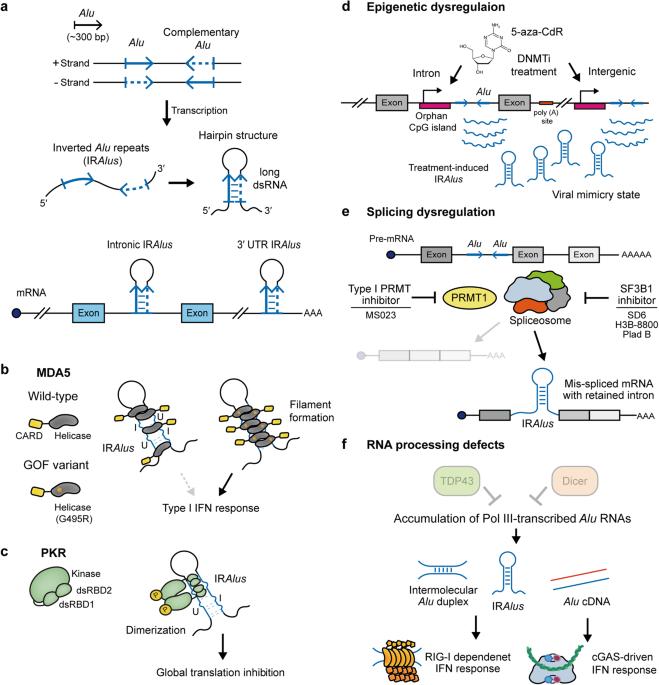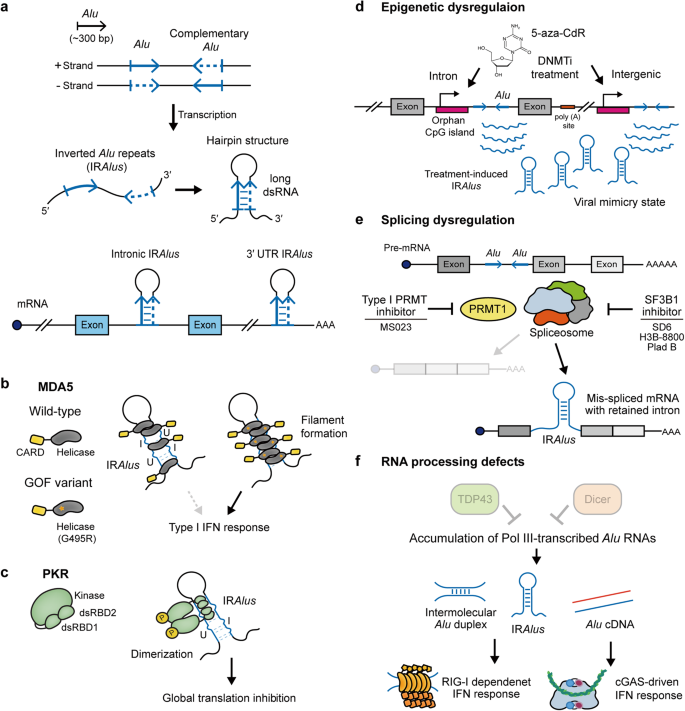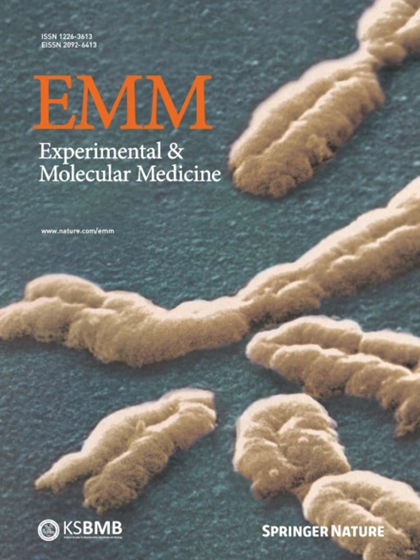Inverted Alu repeats: friends or foes in the human transcriptome
IF 9.5
2区 医学
Q1 BIOCHEMISTRY & MOLECULAR BIOLOGY
引用次数: 0
Abstract
Alu elements are highly abundant primate-specific short interspersed nuclear elements that account for ~10% of the human genome. Due to their preferential location in gene-rich regions, especially in introns and 3′ UTRs, Alu elements can exert regulatory effects on the expression of both host and neighboring genes. When two Alu elements with inverse orientations are positioned in close proximity, their transcription results in the generation of distinct double-stranded RNAs (dsRNAs), known as inverted Alu repeats (IRAlus). IRAlus are key immunogenic self-dsRNAs and post-transcriptional cis-regulatory elements that play a role in circular RNA biogenesis, as well as RNA transport and stability. Recently, IRAlus dsRNAs have emerged as regulators of transcription and activators of Z-DNA-binding proteins. The formation and activity of IRAlus can be modulated through RNA editing and interactions with RNA-binding proteins, and misregulation of IRAlus has been implicated in several immune-associated disorders. In this review, we summarize the emerging functions of IRAlus dsRNAs, the regulatory mechanisms governing IRAlus activity, and their relevance in the pathogenesis of human diseases. Understanding the role of Alu elements—short DNA sequences scattered throughout our genome—is crucial for grasping human genetics. These elements can affect how our genes function, and sometimes, their misregulation causes diseases. However, there’s still much we don’t know about their impact on gene regulation and cell signaling, including innate immune responses. Lee et al. summarized how Alu elements interact with our immune system by generating specific structures similar to ones from viruses. The authors suggest that further understanding of biological processes regulated by Alu elements could lead to advancements in the development of potential treatment for diseases linked to immune system dysfunction. Future research could explore how to manipulate these elements to benefit human health. This summary was initially drafted using artificial intelligence, then revised and fact-checked by the author.


反向 Alu 重复序列:人类转录组中的朋友还是敌人?
Alu元件是一种高度丰富的灵长类特异性短穿插核元件,约占人类基因组的10%。由于它们偏好位于基因丰富的区域,尤其是内含子和 3' UTR,Alu 元件可对宿主基因和邻近基因的表达产生调控作用。当两个方向相反的 Alu 元靠近时,它们的转录会产生不同的双链 RNA(dsRNA),即所谓的反向 Alu 重复序列(IRAlus)。IRAlus 是关键的免疫原性自dsRNA,也是转录后顺式调控元件,在环状 RNA 生物发生以及 RNA 运输和稳定性方面发挥作用。最近,IRAlus dsRNAs 成为转录调节剂和 Z-DNA 结合蛋白的激活剂。IRAlus 的形成和活性可通过 RNA 编辑以及与 RNA 结合蛋白的相互作用来调节,而 IRAlus 的失调与多种免疫相关疾病有关。在这篇综述中,我们总结了 IRAlus dsRNAs 的新功能、支配 IRAlus 活性的调控机制以及它们在人类疾病发病机制中的相关性。
本文章由计算机程序翻译,如有差异,请以英文原文为准。
求助全文
约1分钟内获得全文
求助全文
来源期刊

Experimental and Molecular Medicine
医学-生化与分子生物学
CiteScore
19.50
自引率
0.80%
发文量
166
审稿时长
3 months
期刊介绍:
Experimental & Molecular Medicine (EMM) stands as Korea's pioneering biochemistry journal, established in 1964 and rejuvenated in 1996 as an Open Access, fully peer-reviewed international journal. Dedicated to advancing translational research and showcasing recent breakthroughs in the biomedical realm, EMM invites submissions encompassing genetic, molecular, and cellular studies of human physiology and diseases. Emphasizing the correlation between experimental and translational research and enhanced clinical benefits, the journal actively encourages contributions employing specific molecular tools. Welcoming studies that bridge basic discoveries with clinical relevance, alongside articles demonstrating clear in vivo significance and novelty, Experimental & Molecular Medicine proudly serves as an open-access, online-only repository of cutting-edge medical research.
 求助内容:
求助内容: 应助结果提醒方式:
应助结果提醒方式:


